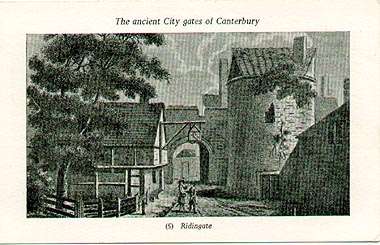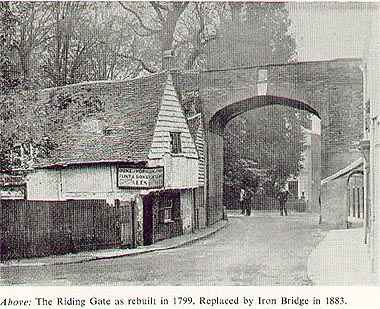|
Riding Gate (now destroyed) - replaced by bridge
in 1883 |
|
|
Roman and later
|
|
|
|
|
|
Postcard from a set of 'Ancient gates of Canterbury',
and drawing (1790), and photo. |
|
|
Notes - taken from William
Urry's account (1948):
|
|
|
The name of this gate has long been the subject of dispute; it has been said to derive from the 'Rider's Gate,' or the 'Reed Gate' from hypothetical reeds growing on this high-lying ground, while a medieval scribe, who knew it as 'Redegate,' thought (with Roman tiles in his mind), it must be 'Red Gate' and translated it into Latin as 'Rubeum Hostium.' Its probable meaning is simply 'Road Gate' the road being the Roman Watling Street which it spanned. The Romans built it as a double-arched gate; remains of this survived down to the end of the 18th century. It was rather like a twin version of Worthgate, having stone jambs, originally around six feet high, with arches composed of tiles. There are suggestions that one arch was larger than the other, so it is possible that one was for wheeled traffic and the other for pedestrians. The gate had no towers, and was not readily defensible. The tower which stood next to it was more properly one of the series of 21 watch towers standing round the wall, and was not an integral part of the gate. Early in the 15th century, the King, with the advice of the Royal Council, ordered it to be walled up. Later on, about 1430, the City authorities opened it again, perhaps at this time inserting the Gothic arch which figures in old prints. The Cathedral monks, deep in one of their eternal quarrels with the City, bitterly complained of this, saying 'it made Canterbury insecure, and that City and Cathedral stood in peril, both because of wars and the danger of heresy in consideracioun bothe to the werres and the high malys of thyse mischewous heresyys and lollardries. At the time of Wyatt's rebellion (1554) the gate was blocked up again with earth and timber, which was removed as soon as the trouble was over. In 1575-6 the timber bridge, connecting the ramparts of the wall either side was reconstructed, but this had decayed away by 1640. Alderman Easday spent a lot of money out of his own pocket on the wall at this point in 1586, though he was a man of limited means. The gate was taken down and replaced in 1799 by a brick arch, erected by Alderman Simmons as part of his scheme for converting the Dane John into a public park. This was replaced in 1883 by a flat steel bridge, badly damaged by enemy action in 1942. Excavations in 1947 brought to light the massive battering base of the watch tower standing to the north of Ridingate. |





